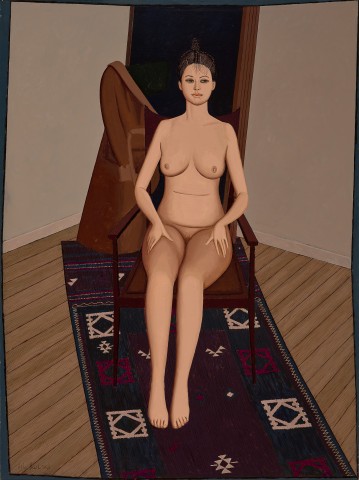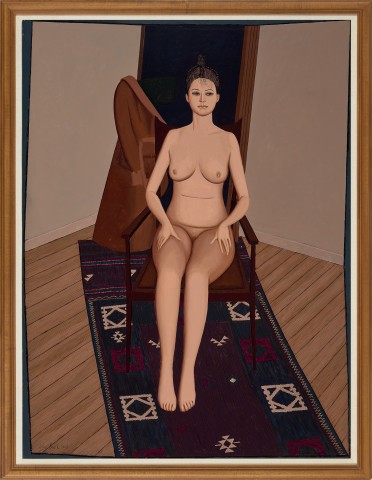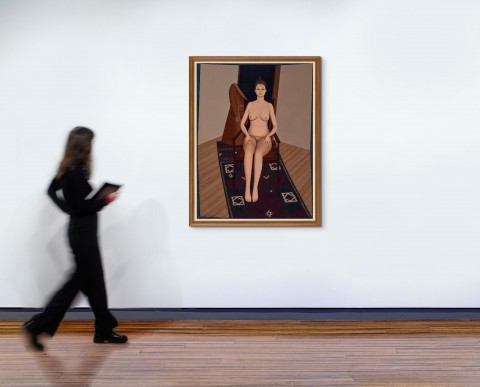SEATED NUDE WITH SCREEN, 1982 - 83
JOHN BRACK
oil on canvas
130.0 x 97.0 cm
signed and dated lower left: John Brack 1982/3
inscribed with title on artist's label attached verso: 'SEATED NUDE WITH SCREEN'
Tolarno Galleries, Melbourne
Joan Clemenger AO and Peter Clemenger AO, Melbourne, acquired from the above in 1983
John Brack, Tolarno Galleries, Melbourne, 21 May - 11 June 1983, cat. 9
John Brack: A Retrospective Exhibition, National Gallery of Victoria, Melbourne, 10 December 1987 – 31 January 1988, cat. 105
The Nude in the Art of John Brack, McClelland Gallery + Sculpture Park, Victoria, 17 December 2006 – 25 March 2007, cat. 15
John Brack Retrospective, The Ian Potter Centre: NGV Australia, 24 April – 9 August 2009 and touring to The Art Gallery of South Australia, Adelaide, 2 October 2009 – 31 January 2010 (label attached verso)
Lindsay, R., John Brack: A Retrospective Exhibition, National Gallery of Victoria, Melbourne, 1987, pp. 73 (illus.), 134, 141
Grishin, S., The Art of John Brack, Oxford University Press, Melbourne, 1990, vol. 1, p. 160, vol. 2, cat. o275, pp. 36, 171 (illus.)
Klepac, L., Australian Painters of the Twentieth Century, Beagle Press, Sydney, 2000, p. 168 (illus.)
Lindsay, R., The Nude in the Art of John Brack, McClelland Gallery + Sculpture Park, Victoria, 2006 (illus., np)
Grant, K., John Brack, National Gallery of Victoria, Melbourne, 2009, pp. 187 (illus.), 225
230616 Brack in Studio_cmyk.jpg
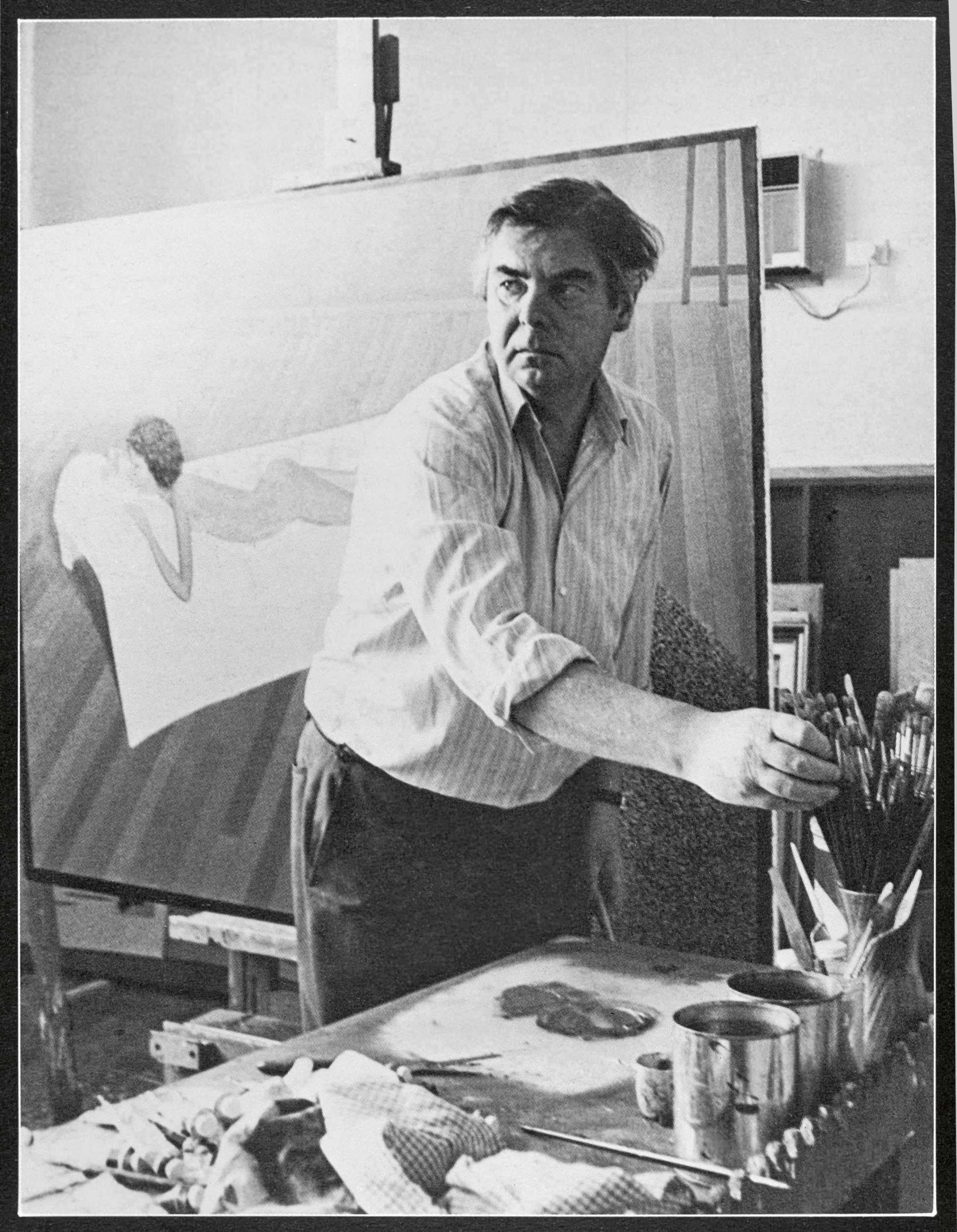
easel and paint completing
February 1977
Like all artists of his generation, John Brack was well-versed in the history of Western art and it remained an essential touchstone throughout his career. A survey of his painting reveals references to significant historical works by artists as diverse as Boucher, Seurat and Buffet, which provided inspiration as he borrowed from earlier masters and challenge as he pitted himself against them. His iconic painting, The bar, 1954 (National Gallery of Victoria), for example, appropriates both the subject and composition of Édouard Manet’s famous depiction of A bar at the Folies-Bergère, 1882 (Courtauld Institute of Art Gallery, London). In Brack’s characteristic way however, the Post-Impressionist’s clever visual trick of depicting the scene in front of the barmaid reflected in a mirror is used to describe the subject as he witnessed it in 1950s Melbourne – a drab image of dour-faced workers who are urgently drinking their fill before the imminent early closing of the pub rather than the gay opulence of 1880s Paris.
220616 John Brack Installation_cmyk.jpg
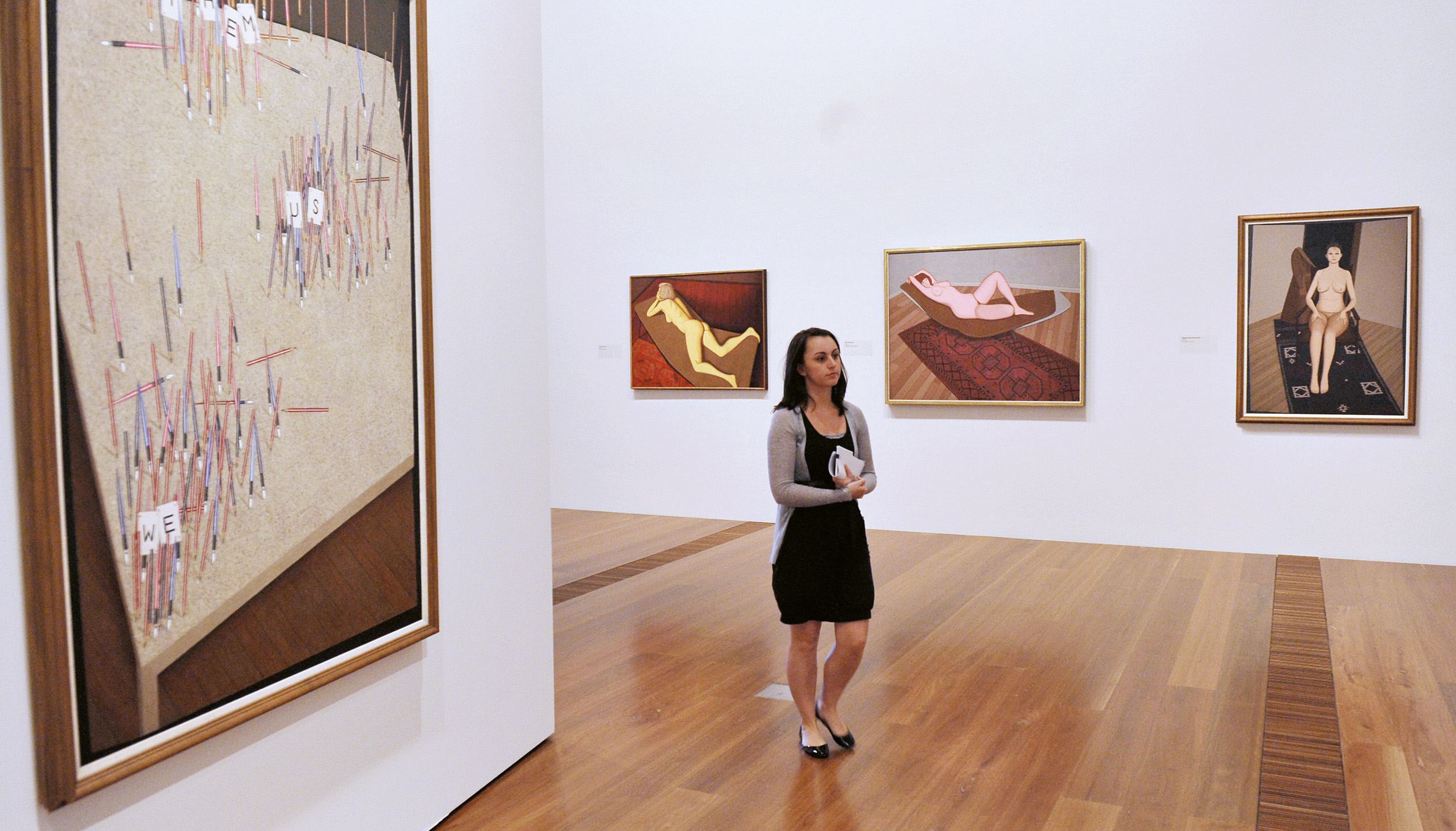
Working within the traditional genres of painting, Brack explored the still-life, portraiture and the nude in his art. Landscape as a theme however, is largely absent from his oeuvre, and indeed, when his friend and fellow artist, Fred Williams, announced that he intended to make the Australian landscape the focus of his art, Brack was sceptical, doubting its relevance as a subject for contemporary painting. Always underlying Brack’s approach – and explaining his avoidance of landscape as a subject – was an enduring interest in the human condition. As he said, ‘What I paint most is what interests me most, that is, people; the Human Condition, in particular the effect on appearance of environment and behaviour… A large part of the motive… is the desire to understand, and if possible, to illuminate… My material is what lies nearest to hand, the people and the things I know best.’1
In the context of the nude, Brack described this focus on human nature in the following way: ‘When I paint a woman… I am not interested in how she looks sitting in the studio, but in how she looks at all times, in all lights, what she looked like before and what she is going to look like, what she thinks, hopes, believes, and dreams. The way the light falls and casts its shadows is merely… a hindrance unless it helps me to show these things.’2 Embarking on his first sustained series of paintings of the nude during the mid-1950s, Brack sought to test the development of his work through a return to the rigour and discipline of life drawing and placed an advertisement for a model in the newspaper. Questions about how he might make a new and meaningful contribution to the genre were answered by the single response he received, from a thin middle-aged woman whose appearance demanded a radically different approach that was far removed from the sensual nudes of earlier artists such as Rubens and Gauguin. Brack quickly realised that ‘there is absolutely nothing whatsoever erotic in an artist’s model unclothed in a suburban empty room’3, and produced a series of striking paintings including Nude in an armchair, 1957 (National Gallery of Victoria) and The bathroom, 1957 (National Gallery of Australia), that boldly challenged expectations of the subject. While some lamented the skinny, sexless appearance of the model, art critic Alan McCulloch wrote that in pitting himself against tradition Brack had successfully demonstrated that ‘he [was] on all occasions master of the medium.’4
220616 John Brack Nude in an armchair_cmyk.jpg
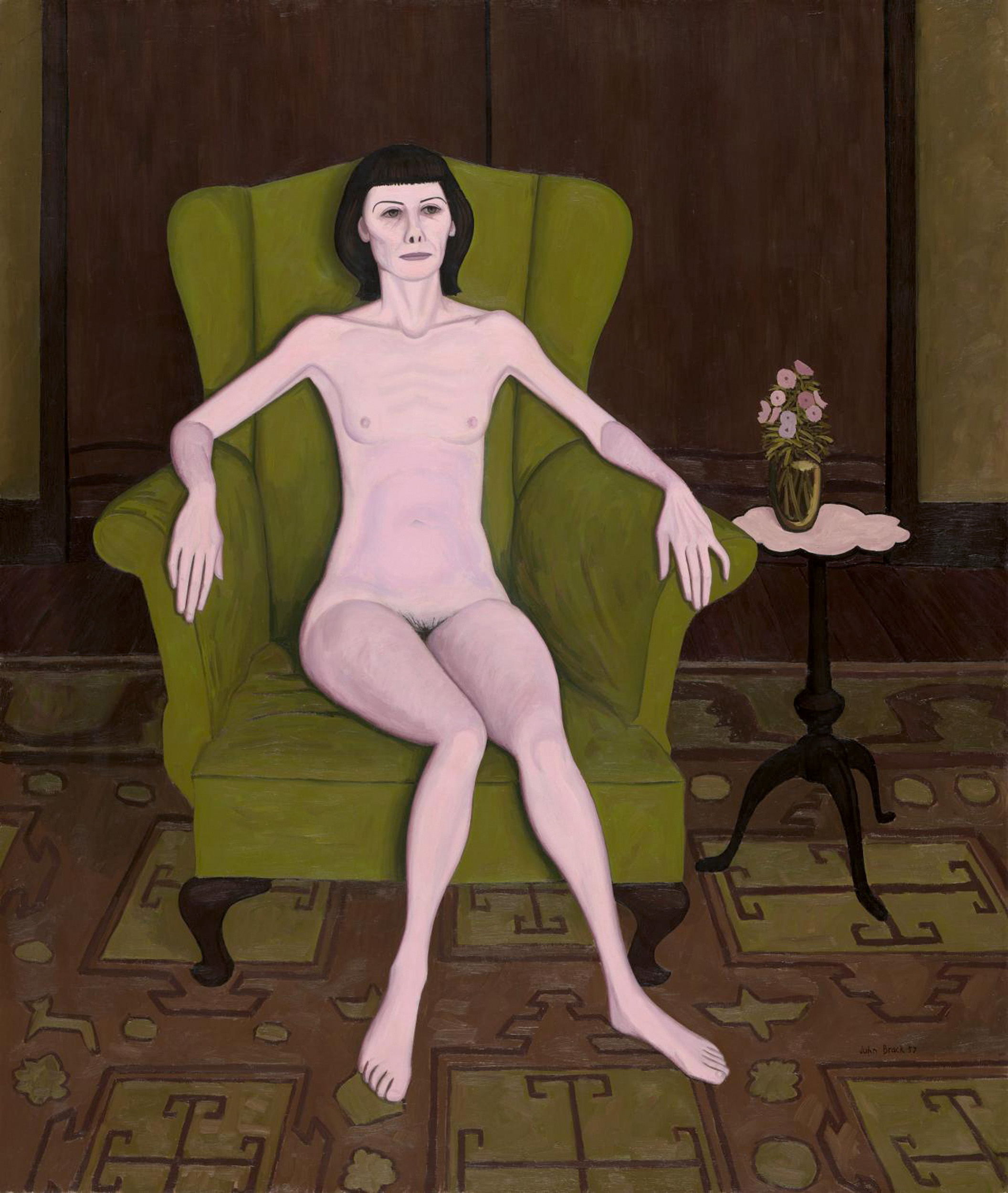
The nude returned as a major subject within Brack’s oeuvre during the 1970s and 80s and in these works a restrained sensuality and pleasure in depicting the female form is apparent. The contrast between the uncomfortable tension of the 1950s nudes and paintings like Seated nude with screen, 1982 – 83, where the subject looks out at the viewer completely at ease with her nakedness, seems to reflect the changes in social mores that had taken place in the intervening years and the increased informality of the late twentieth century. These differences might also point to the development of Brack’s own confidence and artistic maturity. In the mid-1950s he was at the beginning of his career with a handful of solo exhibitions to his name, still defining his visual language and establishing his artistic persona. In 1968, with the help of a monthly stipend from his Sydney dealer Rudy Komon, Brack had resigned from his position as Head of the National Gallery School in Melbourne and for the first time in his life was able to paint full-time. The ensuing decades witnessed regular solo exhibitions, private commissions, as well as other public affirmations of his art.
220616 The Bathroom_cmyk.jpg
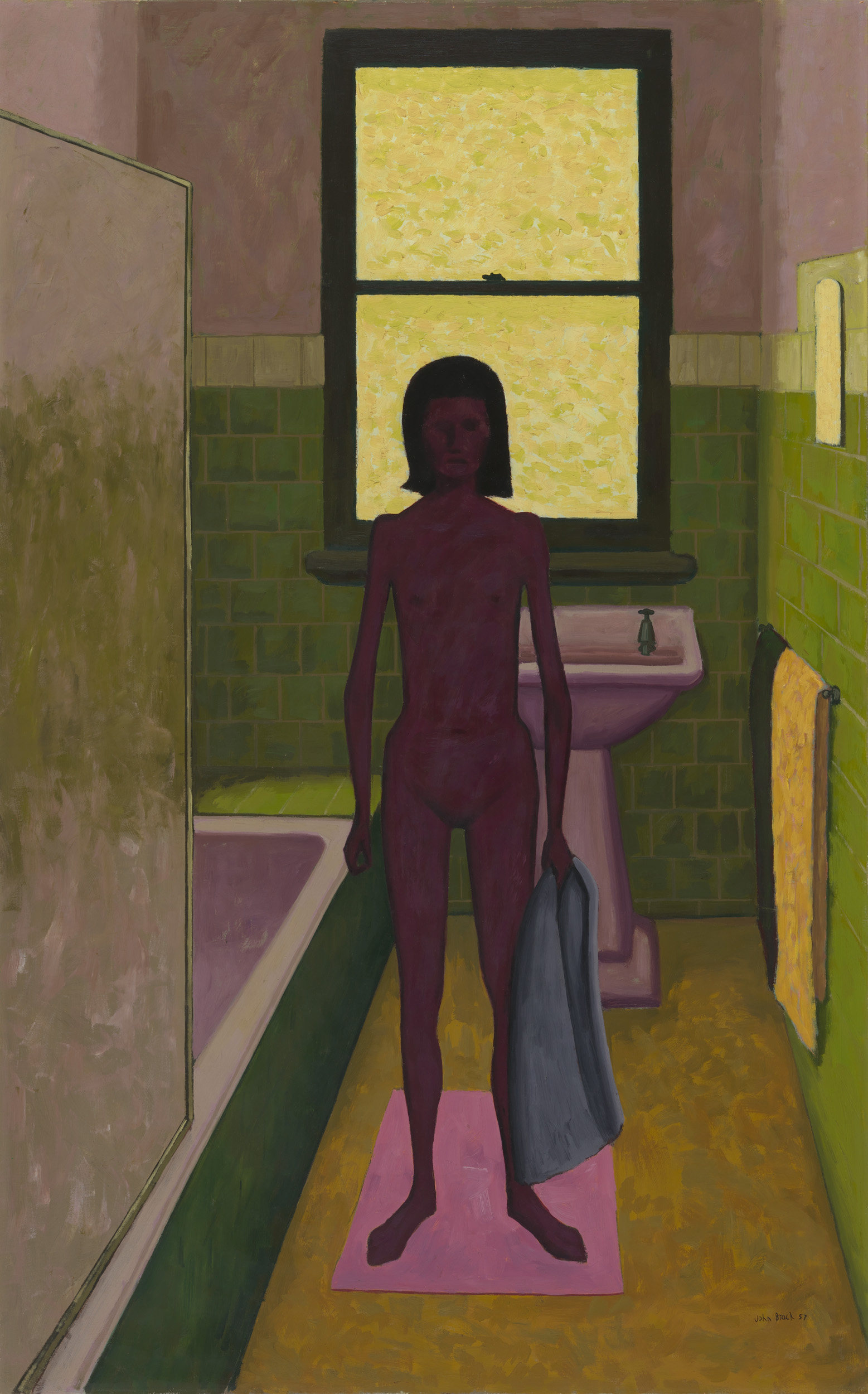
Like all of the nudes from this time, Seated nude with screen was painted in Brack’s studio and features its distinctive timber floorboards and unadorned walls, as well as a Persian carpet, which is rendered in characteristically intricate detail. Helen Brack interprets these carpets as symbolising the world of men and in the context of images where the subject is always female, this has a particular relevance.5
In addition to highlighting what the artist perceived as the differences between the sexes, this pictorial device also illustrates the counterbalance they provide each other.6 In this painting, the centrally-placed figure is prominent within the composition, and the all-over pale tone of her bare skin contrasts with the dark colours and decorative detail of the carpet. Brack has also paid particular attention to the model’s hair, carefully describing its elaborate braiding and the bun that is neatly coiled on top of her head. The model’s clothing often features in these paintings, discarded and casually draped nearby. Here, the figure’s overcoat – presumably hanging on a hook which is attached to the folded screen in the background – assumes a strangely anthropomorphic character and suggests the presence of another figure in the room. What ultimately prevails in this painting however, is what Patrick McCaughey astutely described as Brack’s ‘paramount… sense of observed reality.’7
Joan and Peter Clemenger purchased this painting from Brack’s 1983 exhibition at Tolarno Galleries in Melbourne and, apart from being displayed in several subsequent museum exhibitions – including both the 1987 and 2009 retrospectives at the National Gallery of Victoria – it has graced the walls of their home ever since.8
1. Brack, J., cited in Reed, J., New Painting 1952 – 62, Longman, Melbourne, 1963, p. 19
2. Brack, H., ‘This Oeuvre – The Work Itself’, in Grant, K., John Brack, National Gallery of Victoria, Melbourne, 2009, p. 16
3. Brack, J., Interview, Australian Contemporary Art Archive, no. 1, Deakin University Media Production, 1980, transcript, p. 6
4. McCulloch, A., ‘Classical themes’, Herald, 13 November 1957, p. 29
5. See Lindsay, R., The Nude in the Art of John Brack, McClelland Gallery + Sculpture Park, 2007, n.p.
6. See Helen Brack cited in Gott, T., A Question of Balance: John Brack 1974 – 1994, Heide Museum of Modern Art, Bulleen, 2000, p. 23
7. McCaughey, P., ‘The Complexity of John Brack’ in Lindsay, R., John Brack, National Gallery of Victoria, Melbourne, 1987, p. 9
8. See Exhibition history noted above in the caption for this lot.
KIRSTY GRANT
